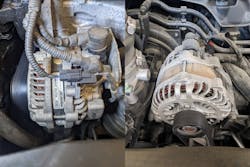What is the purpose of the vehicle’s charging system? The vehicle’s charging system must be capable of supplying the electrical needs of the entire vehicle, including the vehicle’s battery. This low voltage 12-volt battery must be charged so that it’s capable of providing the needed energy to crank and start the Internal Combustion Engine (ICE) when called upon.
Even hybrid and fully electric vehicles have a low voltage system, and that low voltage electrical system will control most of the vehicle’s operational systems. Like the ICE-equipped vehicle, these also have a low voltage battery that needs to be charged allowing for “ready mode” operation.
The amount of power the charging system will be able to produce will be closely matched to the demands of the electrical system of the vehicle it is installed on. The conventional charging system used on the non-hybrid ICE vehicle that we are all familiar with is going to include an alternator. This is the main component responsible for creating the voltage that the electrical systems of the vehicle are going to consume.
The alternator that is being used today is still constructed using a rotor, a stator, a rectifier, and some form of voltage regulator, just as it did when it replaced the old DC generators of the late and early ‘60s.
The alternator’s rotor, propelled by the ICE, will become a spinning electromagnet, that will induce an AC voltage into the three-wired stator assembly. This induced AC voltage will be rectified into a usable DC voltage via a rectifier assembly and the output voltage will be regulated by either an internal or external voltage regulator.
The design of today’s alternators has changed significantly from past designs. The available current output has increased, and the physical size of the alternator unit has decreased dramatically.
Many of today’s alternators can easily produce more than 200 amps from a small and compact design. (The 2020 Ram Diesel is equipped with a 250-amp alternator.) But not just the physical dimensions and output have changed — the operational controls have also changed, with most charging systems becoming “smart charging systems” today.
The alternator can consume a lot of power; about 0.4 horsepower for every 25 amps of current output. The 220-amp alternator on a 2019 Chrysler Pacifica operating at full output could consume about 3.5 hp. It’s important to remember that anything that is consuming power from the ICE is going to be consuming fuel and producing tailpipe emissions.
Using a smart charging system is one area that manufacturers have focused on, for increasing fuel economy and reducing the tailpipe emissions, all while still supplying the ever-increasing electrical demands of today’s vehicles. The smart charging system will rely heavily on knowing the battery’s temperature, state of charge and the vehicle’s electrical demands via a battery or current sensor and controlling the alternator operation.
It is important to note that the stop-start equipped vehicle may also be equipped with an auxiliary DC power source that will need to have its state of charge maintained. The auxiliary DC power source could be in the form of a capacitor, DC-to-DC converter or second battery, but regardless of the type of auxiliary power source, these will also need to be charged and maintained by the charging system, allowing for the proper operation of the stop-start system.
Each manufacturer will have specific charging system protocols and functions. Load shedding, headlight mode, deceleration battery recharging and not using the alternator during engine cranking are examples of some smart charging modes that the manufacturers are using to achieve the most efficient charging system for their vehicle lineup.
GM refers to this as Electrical Power Management. Ford calls their system Smart Charge and Hyundai has the Alternator Management System. The goal is the same in each case: to fine tune the charging system’s operation and maximize the charging system’s efficiency.
The output of the alternator is regulated by the amount of field current supplied to the alternator’s rotor assembly. The field current is provided by the voltage regulator (internal or external) and is fed to the alternator’s meticulously shaped field coil windings that are wrapped around a purposely constructed iron core of the rotor assembly. Controlling the field current will control the strength of the spinning magnetic field created by the rotor, and as a result will control the induced output current of the alternator. The foundation of the smart charging system is to control and decide when the field current is provided and how much current is supplied.
Smart charging systems using an internal voltage regulator will utilize a voltage regulator unit that is mounted inside the alternator assembly. This smart integral voltage regulator will receive operational commands from a control module. The PCM, BCM or other module dedicated to the vehicle’s charging system will broadcast operational commands over either a LIN or CAN communications network. And the alternator will report operational data back about the status of the charging system via that same network wiring.
The smart charging systems that use an external voltage regulator will have their field current controlled and supplied directly from a control module. That control module, often the PCM, will have dedicated voltage regulator circuitry contained internally, removing the voltage regulator from the heat and vibration of the alternator assembly. Dodge, Ram, and Jeep use this method for controlling their smart charging system.
Both smart charging methods have their own pros and cons; but the use of an integral voltage regulator allows for failsafe or default charging operations if a wiring or communications network fails. This is something the externally controlled voltage regulator won’t be able to do if the field control wiring fails.
Testing of the alternator-based smart charging system is going to involve the use of an up-to-date scanner, DVOM, possibly a digital storage oscilloscope (DSO) for communications issues and a proper battery tester designed to test the more common AGM battery. You will also need access to the diagnostics and wiring diagrams.
Common smart charging issues tend to illuminate the Malfunction Indicator Light (MIL) and are commonly wiring related issues, but alternators do fail. The 2016-2019 Ford F150 (various engines) can set a P0625 (Generator Field Terminal Circuit Low) and P065B (Generator Control Circuit Range/Performance) but the alternator will still output a fixed 13.6-13.8 V, because the voltage regulator has entered default mode. The most common cause of this issue is either the GEN RC or GEN L1 wires (alternator communication wires going to the PCM) breaking near the oil pan, or the alternator plug housing these circuits filling with corrosion. Both situations will cause a loss of communications between the internal voltage regulator of the alternator and the PCM. This communications failure will set the DTCs and illuminate both the MIL and charge lights. This concern is often misdiagnosed as a failed alternator because of its fixed charging voltage but a new alternator will not resolve this issue. The communications between the alternator and the PCM must be restored for proper charging operation.
The 2015-2018 Ram 1500 5.7 V8 can set a P2504 (Charging System Output High) due to corrosion or a loose battery positive cable from the alternator to the battery. Diagnosing this problem involves performing a voltage drop (VD) on the cable from the positive post of the alternator to the positive post on the battery. With the alternator operational and charging, the VD should indicate less than 0.2 volts.
Some 2017-2019 Jeep Grand Cherokees will show the “Stop/Start Unavailable Service Stop/Start System” warning message, and the auxiliary battery will not charge. The issue can often be a blown No. 5 fuse in the remote jump post. The fuse can be damaged if the vehicle is boosted.
Hybrid and electric vehicles still require a low voltage charging system that will supply the electrical needs of the low voltage system and maintain the low voltage battery, but it will be done without the use of an alternator. This charging system will involve a DC-to-DC converter that will replace the alternator that was driven by the ICE. This DC-to-DC converter will use solid state devices and controls to transform the voltage from the High Voltage (HV) battery (300-800V DC) down to the 14.5 volts that the low voltage system can use.
Normally, the DC-to-DC converter only supplies 14.5V DC when the vehicle is in normal drive cycle operation or ready mode. But, there are times where the low voltage system will be awake and require operational voltage.
If the vehicle’s HV battery is being charged, the HV battery needs warming or cooling, or other vehicle operational needs are required, some of the low voltage power modules or low voltage systems may be operational and consuming power from the low voltage DC battery. This battery needs to be maintained; in some cases the DC-to-DC converter may be in operation to do that task. The common DC-to-DC converter can supply up to 130A of 14.5V power.
Note: Tesla started to equip their vehicles with a 15.5V lithium battery in 2021, replacing the 12V lead acid battery. The 15.5V lithium battery is better suited to their HV vehicle electrical architecture, is more compact and weighs less. But boosting, testing, and maintaining this battery requires special dedicated tools.
Testing of the DC-to-DC converter is going to involve the use of an up-to-date scan tool and the needed code diagnostics if there are codes set in the DC-to-DC converter system. We need to remember all the safety protocols and PPE that may be needed if we are asked to diagnose or test the DC-to-DC converter system because we may be exposed to the HV system.
Another common tool that is going to be needed to inspect a DC-to-DC converter charging issue is the carbon pile tester. The carbon pile tester is the preferred method to test the low voltage system output of the DC-to-DC converter. Watching the low voltage system’s output while applying a load with the carbon pile tester should indicate an increase in the system’s target current level. If a carbon pile tester isn’t available, the scanner may be used to increase the DC-to-DC converter output level.
The design and construction of the alternator has changed dramatically over time. It’s gotten more powerful, smaller, and more efficient. But the alternator is still using the same electromagnetic principles to provide the electrical needs of the ICE-equipped vehicle. But the charging systems of the future are changing. They are all “smart,” or don’t use an alternator at all, like the DC-to-DC converter charging system. Even the low voltage battery responsible for starting or enabling the vehicle is undergoing changes to improve the charging systems function.


